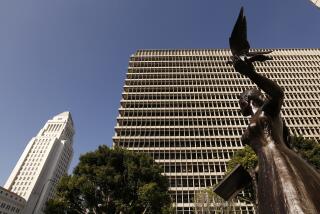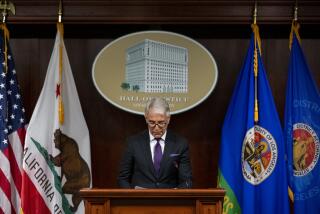Prosecution Says Rubino Helped Citron Steal Funds
- Share via
SANTA ANA — On the opening day of the first criminal trial stemming from the Orange County bankruptcy, former County Budget Director Ronald S. Rubino was portrayed by the prosecution as an ambitious official who helped steal millions of dollars so he could solve the county’s budgetary woes and enhance his career.
The money--$91 million in 1993 alone--was taken from the investment pool accounts of cities and school districts that entrusted their funds to then-Treasurer-Tax Collector Robert L. Citron, who managed the county’s $7-billion investment portfolio, Assistant Dist. Atty. Jan Nolan said.
Rubino, according to the prosecutor, was among those county employees who concocted and carried out a plan to divert interest earnings from the investment pool to benefit the county’s general fund.
At one point, the group even joked about calling the misappropriated money the “Bob Citron Endowment Fund,” but dropped that idea in favor of the “Economic Uncertainty Fund.”
Nolan told the jury of 11 women and one man that she planned to call Citron as a witness to prove that Rubino knew about the misappropriation of funds.
Rubino, 44, faces two felony counts of aiding and abetting Citron in the illegal diversion scheme to which Citron has already pleaded guilty.
If convicted of the two felonies he is charged with, Rubino faces up to nine years in prison.
Citron pleaded guilty to six felonies and is cooperating with prosecutors. His deputy, Matthew Raabe, has pleaded innocent to the same six felony charges as were brought against Citron, and faces trial in September.
Rubino’s attorney, Rodney Perlman, vehemently disputed Nolan’s contention that Citron would implicate his client.
To the contrary, Perlman said, Citron told prosecutors he never informed Rubino that the diverted funds were being stolen from the cities and school districts.
In contrast to the image sketched by the prosecution, Perlman described his client as a loyal public servant, a technocrat who was simply taking orders from his elected bosses.
Rubino was “acting unselfishly, doing nothing more than he was hired to do,” Perlman said.
“He was merely assisting the Board of Supervisors in finding ways to pay for the services the county gives to all of its citizens. . . . What you have before you is a good and honest . . . public servant,” he told jurors.
The small, sixth-floor courtroom in the Superior Court building here was packed to capacity for the trial’s opening statements. Rubino’s relatives and supporters occupied an entire side of the cramped public gallery. On the other side sat lawyers for Raabe, the U.S. Securities and Exchange Commission and Merrill Lynch & Co., the giant Wall Street brokerage that sold Citron most of the securities on which the county lost $1.6 billion.
In her opening statement, Nolan told the jury that she was not seeking to prove that Citron or Rubino “lined their pockets” or that they caused one of the wealthiest counties in the United States to declare bankruptcy.
“What I am going to prove to you is that Mr. Citron, as treasurer-tax collector, diverted, stole, misappropriated the funds of investors and gave them to the county general fund. And Mr. Rubino helped him, encouraged him,” Nolan said.
Nolan said Citron and Raabe, his top assistant, wanted to divert interest earnings from the investment pool because they were worried that the pool’s outside investors might be startled by the excessive interest Citron’s investments were earning at one point, and might have started raising questions about the risks associated with such returns.
During a period when the state of California’s investment pool was earning annualized interest of 4.5%, Citron was raking in about 11.5%, having purchased some of the most speculative securities that Wall Street could offer, Nolan said.
The treasurer’s office surmised that if pool investors were actually paid what their deposits were earning, “they were going to know there was an awful lot of risk in this pool,” Nolan said.
And that, Nolan said, could have caused “a run on the bank if they reported [the high-interest earnings]. It could blow the lid off this . . . [investment] pool,” she added.
In league with the others, Citron decided to report earnings of about 7.85% and shift the remainder to the Economic Uncertainty Fund, Nolan said.
Rubino, who was described by Nolan as a popular county employee who was eyeing the county administrative officer’s job, had a different problem, according to Nolan.
In 1993, a prolonged recession was taking its toll on tax revenue and Rubino was struggling to balance the county budget, Nolan said. Because he worked for elected officials who were highly sensitive to service cutbacks and county layoffs, Rubino was anxious to come up with revenue, she said.
“So here you have Mr. Citron. He’s got a truck full of money, and he’s looking for a new home [for it]. Mr. Rubino has a huge [budgetary] hole, and that is the motive” for the diversion scheme, Nolan said.
In November of 1993, Rubino and others decided to place the misappropriated funds in a separate account that would earn interest--to “create a new revenue stream” for the county, Nolan said.
Nolan said Rubino successfully lobbied the Board of Supervisors to “take this money, lock it up, and only [use it] for county purposes.” A resolution that Rubino pushed through required the approval of four of the five supervisors before these funds could be spent, Nolan said.
But Perlman said Rubino was only following orders and budgeting money, not “obtaining” it.
The defense attorney denied Nolan’s assertions that Rubino used the diverted money to balance the budget. He said Rubino had successfully spearheaded a move to cut 1,000 jobs from the county’s payroll in 1993.
And the diverted money went into the Economic Uncertainty Fund, not to balance the county’s budget, Perlman said.
Perlman said his client didn’t know about any diversion scheme. Citron had told several county officials, including Rubino, that he was earning extra money by making “extra efforts for the county,” and that he had perfected a system for investing in “derivatives,” the risky securities in which he invested, and which turned out to be wrong-way bets on the direction in which interest rates would move.
Citron, Perlman said, was conducting his investment scheme “in a very public way.”
And despite his high yields, “no one raised an issue, and no one said there was anything illegal about it,” Perlman said.
Perlman told the jurors that the responsibility for auditing the treasurer’s books rested squarely with the auditor-controller’s office.
Perlman said he plans to show that officials in the auditor’s office “never considered what they were being told [about the interest diversion] as being criminal.”
Perlman acknowledged that Rubino helped devise a plan to place interest earnings in the Economic Uncertainty Fund, but he didn’t know the funds were being taken from the other investors.
“It was put in a reserve account, where it stayed,” Perlman said.
Representatives of four agencies with money in the ill-fated Orange County Investment Pool were the first witnesses called to testify Monday afternoon. They were John Nelson, assistant superintendent of the Orange County Department of Education; Susan Morse, the Laguna Beach city treasurer; and officials of two South County water districts.
They testified that their agencies did not give anyone permission to take their interest earnings from the investment pool.
Under cross-examination, the witnesses said they never questioned Citron’s high rate of return.
Morse said her city received $1,593,000 back on a $750,000 investment, but never asked how Citron managed to more than double the city’s investment.
The trial, which is expected to last three months, continues today.
More to Read
Sign up for Essential California
The most important California stories and recommendations in your inbox every morning.
You may occasionally receive promotional content from the Los Angeles Times.










